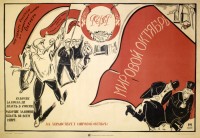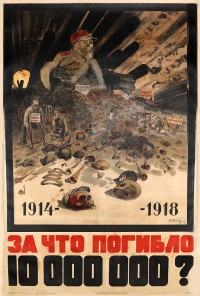State Publishing House
The State Publishing House had its origins in Imperial Russia as the Royal Print Yard of St. Petersburg. In 1917, the Soviets nationalized the print yard and requisitioned its presses. From requisitioning emerged the Publishing House of the Petrograd Soviet that was formed in the winter of 1917 by the Literary and Publishing Department of People's Commissariat for Education. In 1919, the State Publishing House in St. Petersburg changed its name to Petrogosizdat (Petrograd State Publishing) and in 1924, to Lengosizdat (Leningrad State Publishing, a.k.a., Lengiz) when St. Petersburg changed to Leningrad in honor of Vladimir Lenin. As the Red Army controlled more provinces and cities within Russia, the State Publishing House developed auxiliary offices outside St. Petersburg. In May 1919, VTsIK (All-Russian Central Executive Committee) established in Moscow the State Publishing House of the RSFSR (Russian Soviet Federative Socialist Republic), a.k.a. Gosizdat, to manage all publishing activity. Over time, additional publishing departments for the state were created around Soviet Russia and in the outlying Soviet republics.
Sources & Citations
Koenker, D. (2005). Republic of labor: Russian printers and Soviet socialism, 1918-1930. Ithaca: Cornell University Press.
Bonnell, V.E. (1999). Iconography of power: Soviet political posters under Lenin and Stalin. Berkeley: University of California Press.
Rosenfeld, A. [Ed.]. (1999). Defining Russian graphic arts: From Diaghilev to Stalin, 1898-1934. New Brunswick: Rutgers Univ. Press. (p. 209, publishing history of the USSR)
White, S. (1998). The Bolshevik poster. New Heaven: Yale University Press. (history of State Publishing House)
Ruud, C. A. (1990). Russian entrepreneur: Publisher Ivan Sytin of Moscow: 1851-1934. Montreal: McGill-Queen's University Press. (development of the State Publishing House)
![PP 042: October 25, 1917 -- November 7, 1920
Farmer, you used to work for a landlord!
Now the land belongs to the working people!
All Power to the Soviets!
[Partial translation]](https://www.posterplakat.com/thumbs/the-collection/posters/pp-042/pp042-190x300.jpg)



![PP 440: Curses, curses on Polish landlords!
Death and shame on perpetrators of violence!
Comrades-brothers, hurry and take up your rifles
to launch the last counter-attack against them!
[Partial translation]](https://www.posterplakat.com/thumbs/the-collection/posters/pp-440/pp440-200x127.jpg)



![PP 749: Why did the Civil War Start?
[In the circle] From the first days of its existence the Soviet Republic has had to stand against the military forces of the White Army.
[Partial translation]](https://www.posterplakat.com/thumbs/the-collection/posters/pp-749/pp749-200x133.jpg)

![PP 914: To the Aid of Pans! [Polish landlords] The Last Reserves of Marshal Foch](https://www.posterplakat.com/thumbs/the-collection/posters/pp-914/pp-914-catalog-image-200x300.jpg)

